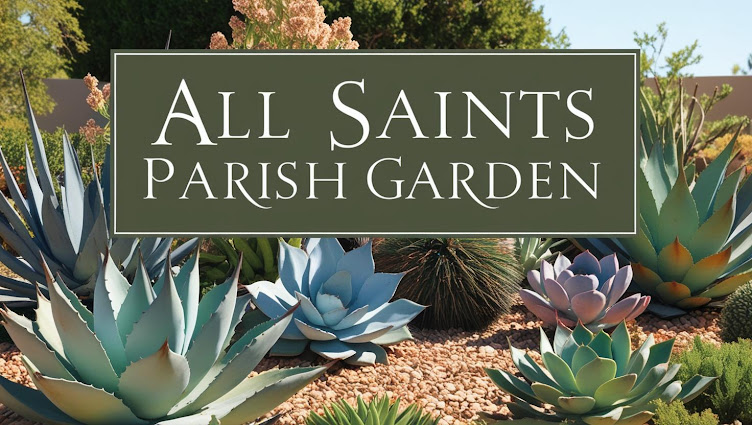With the lawn removed and the new soil in place, it was now time for the fun part...actually planting a garden! Much like painting a house, a huge part of the project is the prep work. While planting seems straightforward, there were actually five phases to this chapter of the project: 1. Procuring the Plants (within our shoestring budget), 2. Placement of Plants, 3. Actually Planting the Plants and Installing a Border, 4. Running Irrigation, and 5. Mulch. And while mulch sounds like the easiest of those tasks, it was actually a full day involving a dump truck, half a dozen church volunteers, and countless hours.
1. Procuring - An instant, striking garden planted with 5, 10, and 15 gallon specimen plants would be amazing, but was not economically feasible for this project. In fact, there is something magical about planting tiny four inch plants and watching a landscape transform from a polkadot grid of plants to an emerging jungle. I think it's probably better for the plants too, as they wont be root-bound having never been cooped up in pots for who knows how long. My husband, Max Cannon (the infamous "Planty Magoo") is a Plant Wizard. He has worked almost ever position in the plant industry: as a landscape designer, an estimator, a nursery salesperson, a Plant Buyer (that was actually his title...a job he had been preparing for his whole life!), and Horticulturist. Procuring plants is Max's specialty-- he is connected to every obscure grower and nursery from Washington State to San Diego. Another incredible plant guru is the illustrious Bill Holliday who is a dear friend and travel companion. Because the church is a 501(c)(3) nonprofit organization, Bill helped us get a $200 donation (credit) from Devil Mountain Wholesale Nursery for this project, and my husband Max helped me procure the list of plants from our design from Devil Mountain and other wholesale nurseries. We even received some plants from Farallon Gardens where David works, an inspiring landscape design company in the SF Bay Area owned by our friend Mat McGrath. It takes a village, and thankfully my village is full of "plant people."
2. Placing - When you lay something out on paper, especially when it's not exactly to scale, it's hard to imagine what it will look like once planted. We did our best to layout the plants according to the plans, making some adjustments for the bonus plants, which included various agaves.
I know it might seem silly, but I ran a string held up by stakes the whole length of the landscape along the sidewalk to discourage people from walking on it. With the elementary school next door, I knew soon we would have hundreds of children and parents walking by. Miraculously, the little string worked! It was just strong enough of a message that, as I peeked out my office window, I could see children walking by and running their hands along the string, clearly understanding its intent.
4. Irrigation - In order for this, or any garden project, to thrive at the church irrigation is essential. While many gardens I know of in the East Bay, including my own home garden, are purely hand-watered, at the church irrigation is essential. Our church gardener is contracted for 4 hours every other week and I run a church full-time. Also, we can't forget that throughout the year staff take vacation and sometimes the garden goes weeks without attention. Have I mentioned already that this project wouldn't have been possible without the help of my friend David? He works full-time, so he assisted me with this garden project on weekends and evenings after work, and was the force behind getting this extensive drip irrigation system in place. David is one of those gardening superheroes who can do anything!
5. Mulch - With plants and irrigation in place, the final step was to have a dump truck of mulch delivered and rally a team to cover the garden with mulch. We ordered 12 cubic yards of 1/2 fir bark from American Soil, which was delivered smack dab in the middle of our walkway. I chose that location because it was a midpoint between the two sides, and it forced us to complete the mulching in a day. A group of us gathered on Earth Day 2024 to mulch the garden including a whole team from our church: Greg Nunes, Dawn Cassasola, Ray Glassley, Joy Korst, and Larry Churchill. What a great team!
Nothing pulls a new landscape together like a fresh, thick layer of mulch. I know we could have saved a lot of money by having the free wood chips delivered that you can get from tree-trimming companies, but my plant gurus recommended this 1/2 inch fir and I think it looked incredible! I believe this garden project came in close to $8,000 total, including everything, and I am so proud of the team of people who helped make this happen. Now that you have the backstory, and have witnessed the birth of this garden, it will be fun to share some posts on its transformation over the past year.












When you look at the finished picture, it's easy to forget what actually goes into making a garden. This is a great post because it details every single step!
ReplyDeleteI learned a whole lot in the process. I'm a priest and casual gardener, and basically was thrown into the deep as a landscape contractor for this project.
DeleteIndeed that mulch layer makes it all sing! I had to laugh at "making some adjustments for the bonus plants, which included various agaves"... yay for bonus agaves!
ReplyDeleteHa! And they will get huge. There's even a couple neat variegated ones.
Delete